fuel consumption BMW I8 2014 I12 Owner's Manual
[x] Cancel search | Manufacturer: BMW, Model Year: 2014, Model line: I8, Model: BMW I8 2014 I12Pages: 216, PDF Size: 12.45 MB
Page 6 of 216
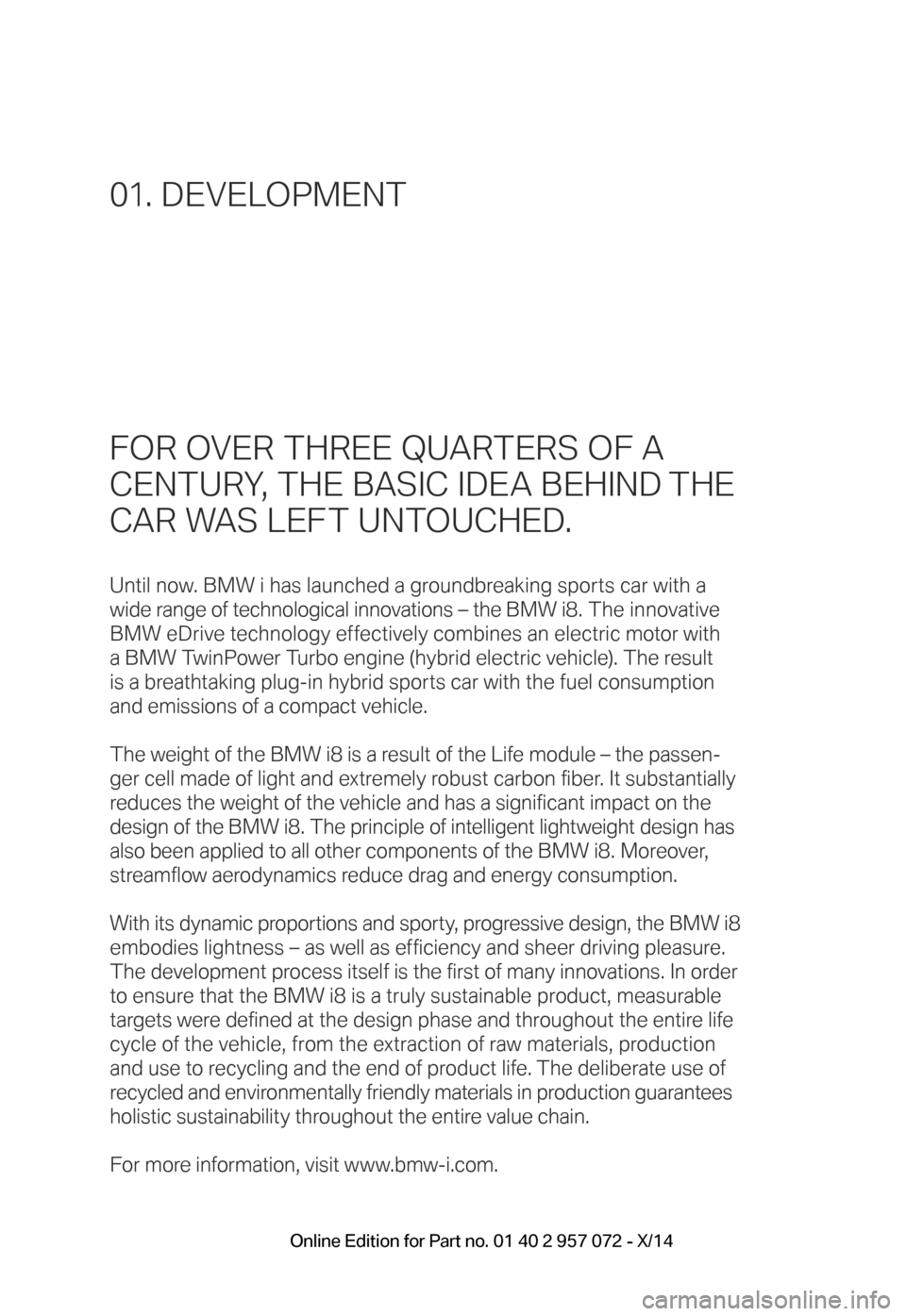
FOR OVER THREE QUARTERS OF A
CENTURY, THE BASIC IDEA BEHIND THE
CAR WAS LEFT UNTOUCHED.
Until now. BMW i has launched a groundbreaking sports car with a
wide range of technological innovations ā the BMW i8. The innovative
BMW eDrive technology effectively combines an electric motor with
a BMW TwinPower Turbo engine (hybrid electric vehicle). The result
is a breathtaking plug-in hybrid sports car with the fuel consumption
and emissions of a compact vehicle.
The weight of the BMW i8 is a result of the Life module ā the passen-
ger cell made of light and extremely robust carbon fiber. It substantially
reduces the weight of the vehicle and has a significant impact on the
design of the BMW i8. The principle of intelligent lightweight design has
also been applied to all other components of the BMW i8. Moreover,
streamflow aerodynamics reduce drag and energy consumption.
With its dynamic proportions and sporty, progressive design, the BMW i8
embodies lightness ā as well as efficiency and sheer driving pleasure.
The development process itself is the first of many innovations. In order
to ensure that the BMW i8 is a truly sustainable product, measurable
targets were defined at the design phase and throughout the entire life
cycle of the vehicle, from the extraction of raw materials, production
and use to recycling and the end of product life. The deliberate use of
recycled and environmentally friendly materials in production guarantees
holistic sustainability throughout the entire value chain.
For more information, visit www.bmw-i.com.
01. DEVELOPMENT
BMW_i8_Bedienungseinleger_210x138mm_US.indd 415.01.14 17:53 Online Edition for Part no. 01 40 2 957 072 - X/14
Page 11 of 216
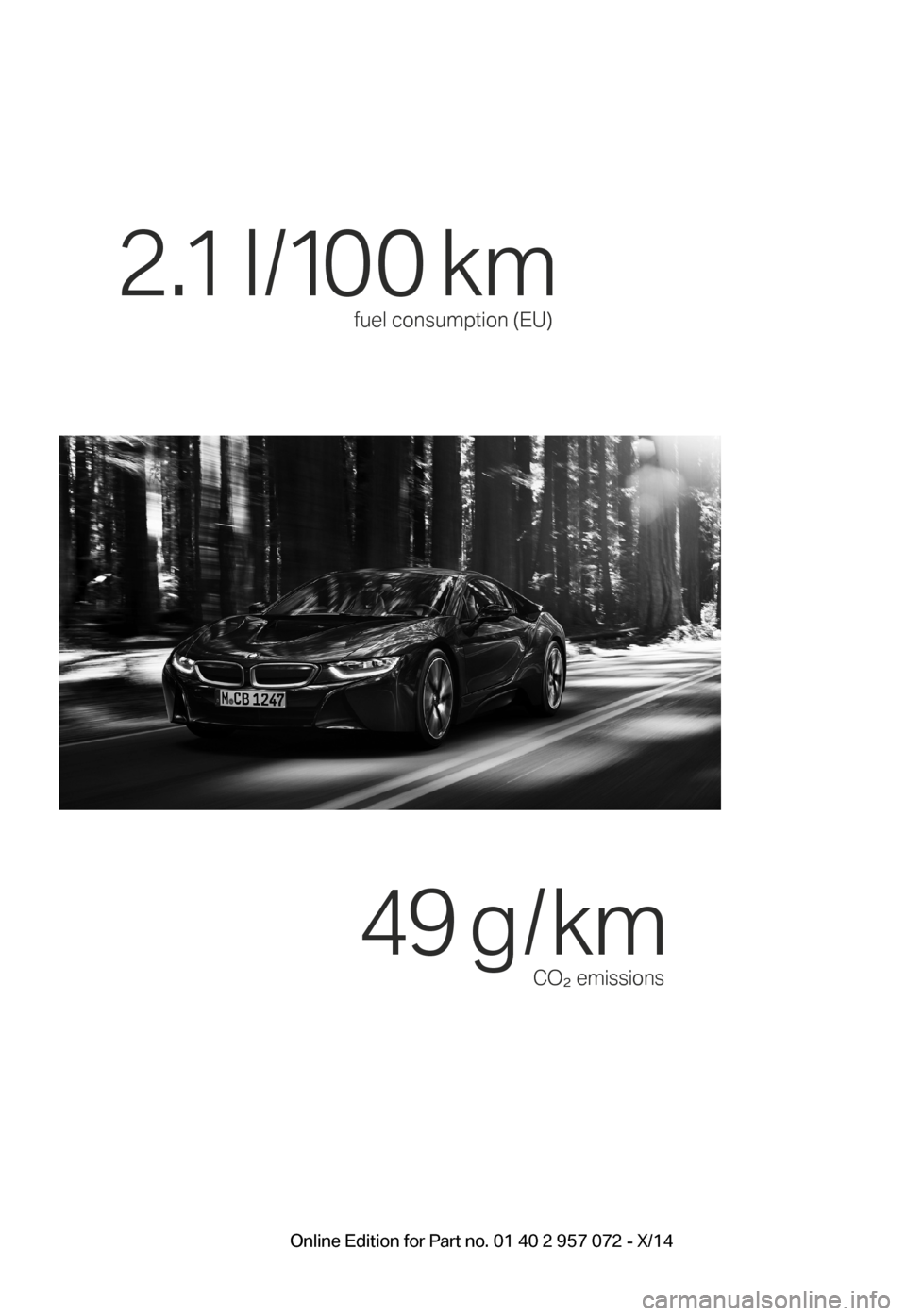
fuel consumption (EU)
2.1 l /100 km
COĀ² emissions
49 g / km
BMW_i8_Bedienungseinleger_210x138mm_US.indd 915.01.14 17:53Online Edition for Part no. 01 40 2 957 072 - X/14
Page 47 of 216
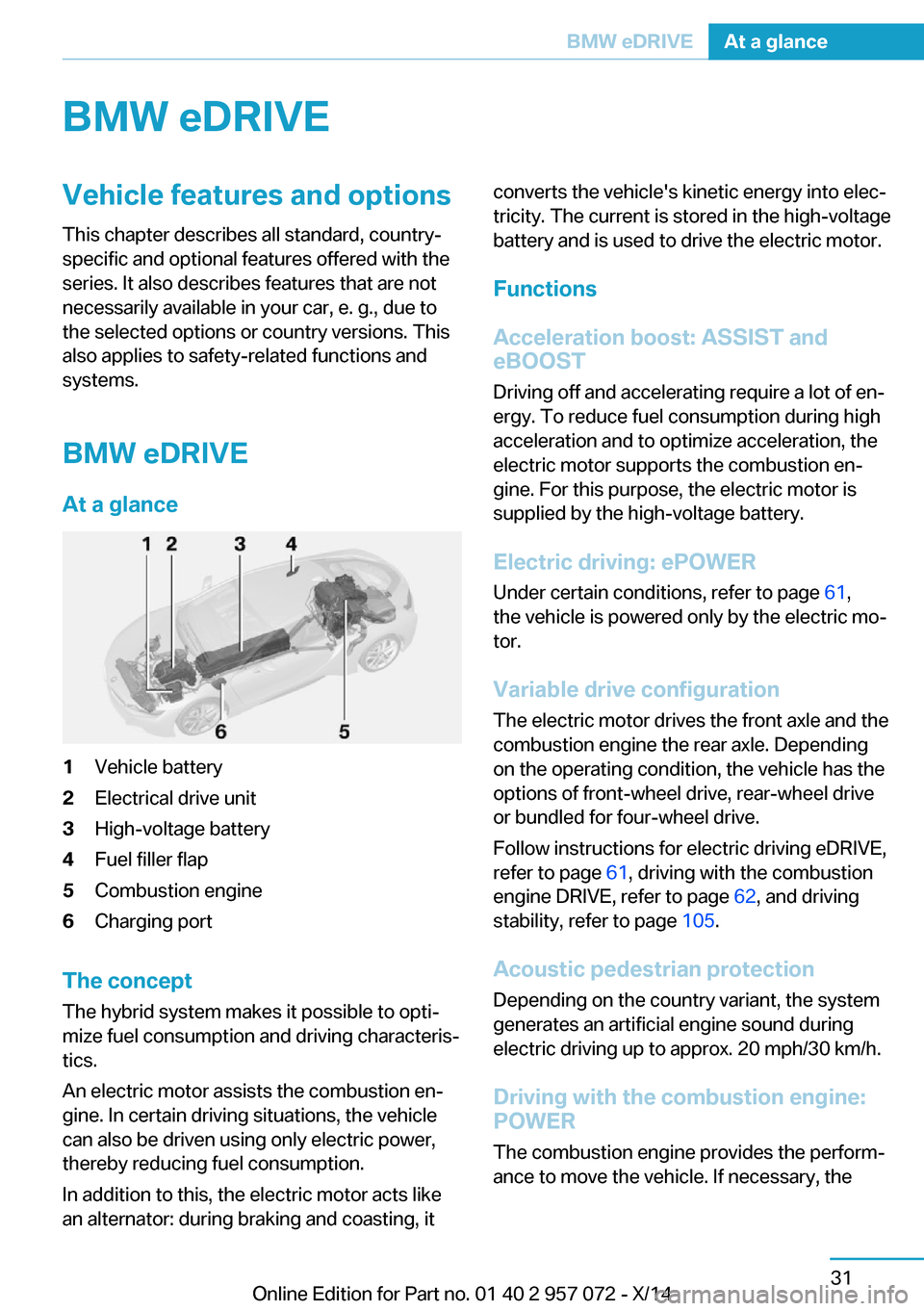
BMW eDRIVEVehicle features and options
This chapter describes all standard, country-
specific and optional features offered with the
series. It also describes features that are not
necessarily available in your car, e. g., due to
the selected options or country versions. This
also applies to safety-related functions and
systems.
BMW eDRIVEAt a glance1Vehicle battery2Electrical drive unit3High-voltage battery4Fuel filler flap5Combustion engine6Charging port
The concept The hybrid system makes it possible to optiā
mize fuel consumption and driving characterisā
tics.
An electric motor assists the combustion enā
gine. In certain driving situations, the vehicle
can also be driven using only electric power,
thereby reducing fuel consumption.
In addition to this, the electric motor acts like
an alternator: during braking and coasting, it
converts the vehicle's kinetic energy into elecā tricity. The current is stored in the high-voltage
battery and is used to drive the electric motor.
Functions
Acceleration boost: ASSIST and eBOOST
Driving off and accelerating require a lot of enā
ergy. To reduce fuel consumption during high
acceleration and to optimize acceleration, the
electric motor supports the combustion enā
gine. For this purpose, the electric motor is
supplied by the high-voltage battery.
Electric driving: ePOWER
Under certain conditions, refer to page 61,
the vehicle is powered only by the electric moā
tor.
Variable drive configuration
The electric motor drives the front axle and the
combustion engine the rear axle. Depending
on the operating condition, the vehicle has the
options of front-wheel drive, rear-wheel drive
or bundled for four-wheel drive.
Follow instructions for electric driving eDRIVE,
refer to page 61, driving with the combustion
engine DRIVE, refer to page 62, and driving
stability, refer to page 105.
Acoustic pedestrian protection Depending on the country variant, the system
generates an artificial engine sound during
electric driving up to approx. 20 mph/30 km/h.
Driving with the combustion engine:
POWER
The combustion engine provides the performā
ance to move the vehicle. If necessary, theSeite 31BMW eDRIVEAt a glance31
Online Edition for Part no. 01 40 2 957 072 - X/14
Page 48 of 216
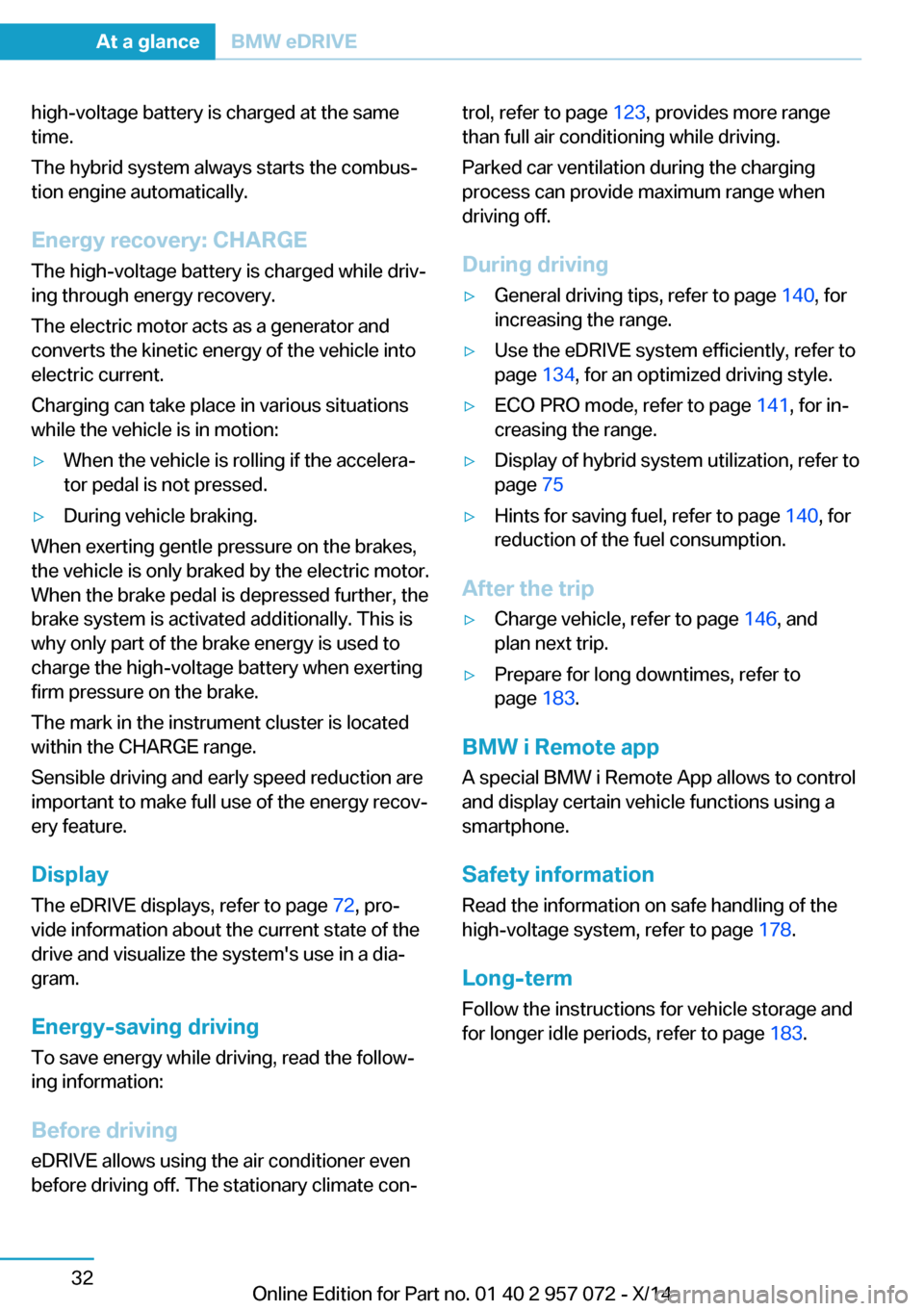
high-voltage battery is charged at the same
time.
The hybrid system always starts the combusā
tion engine automatically.
Energy recovery: CHARGE The high-voltage battery is charged while drivā
ing through energy recovery.
The electric motor acts as a generator and
converts the kinetic energy of the vehicle into
electric current.
Charging can take place in various situations
while the vehicle is in motion:ā·When the vehicle is rolling if the acceleraā
tor pedal is not pressed.ā·During vehicle braking.
When exerting gentle pressure on the brakes,
the vehicle is only braked by the electric motor.
When the brake pedal is depressed further, the
brake system is activated additionally. This is
why only part of the brake energy is used to
charge the high-voltage battery when exerting
firm pressure on the brake.
The mark in the instrument cluster is located
within the CHARGE range.
Sensible driving and early speed reduction are
important to make full use of the energy recovā
ery feature.
Display The eDRIVE displays, refer to page 72, proā
vide information about the current state of the
drive and visualize the system's use in a diaā
gram.
Energy-saving driving To save energy while driving, read the followā
ing information:
Before driving eDRIVE allows using the air conditioner even
before driving off. The stationary climate conā
trol, refer to page 123, provides more range
than full air conditioning while driving.
Parked car ventilation during the charging
process can provide maximum range when
driving off.
During drivingā·General driving tips, refer to page 140, for
increasing the range.ā·Use the eDRIVE system efficiently, refer to
page 134, for an optimized driving style.ā·ECO PRO mode, refer to page 141, for inā
creasing the range.ā·Display of hybrid system utilization, refer to
page 75ā·Hints for saving fuel, refer to page 140, for
reduction of the fuel consumption.
After the trip
ā·Charge vehicle, refer to page 146, and
plan next trip.ā·Prepare for long downtimes, refer to
page 183.
BMW i Remote app
A special BMW i Remote App allows to control
and display certain vehicle functions using a
smartphone.
Safety information Read the information on safe handling of the
high-voltage system, refer to page 178.
Long-term Follow the instructions for vehicle storage and
for longer idle periods, refer to page 183.
Seite 32At a glanceBMW eDRIVE32
Online Edition for Part no. 01 40 2 957 072 - X/14
Page 91 of 216
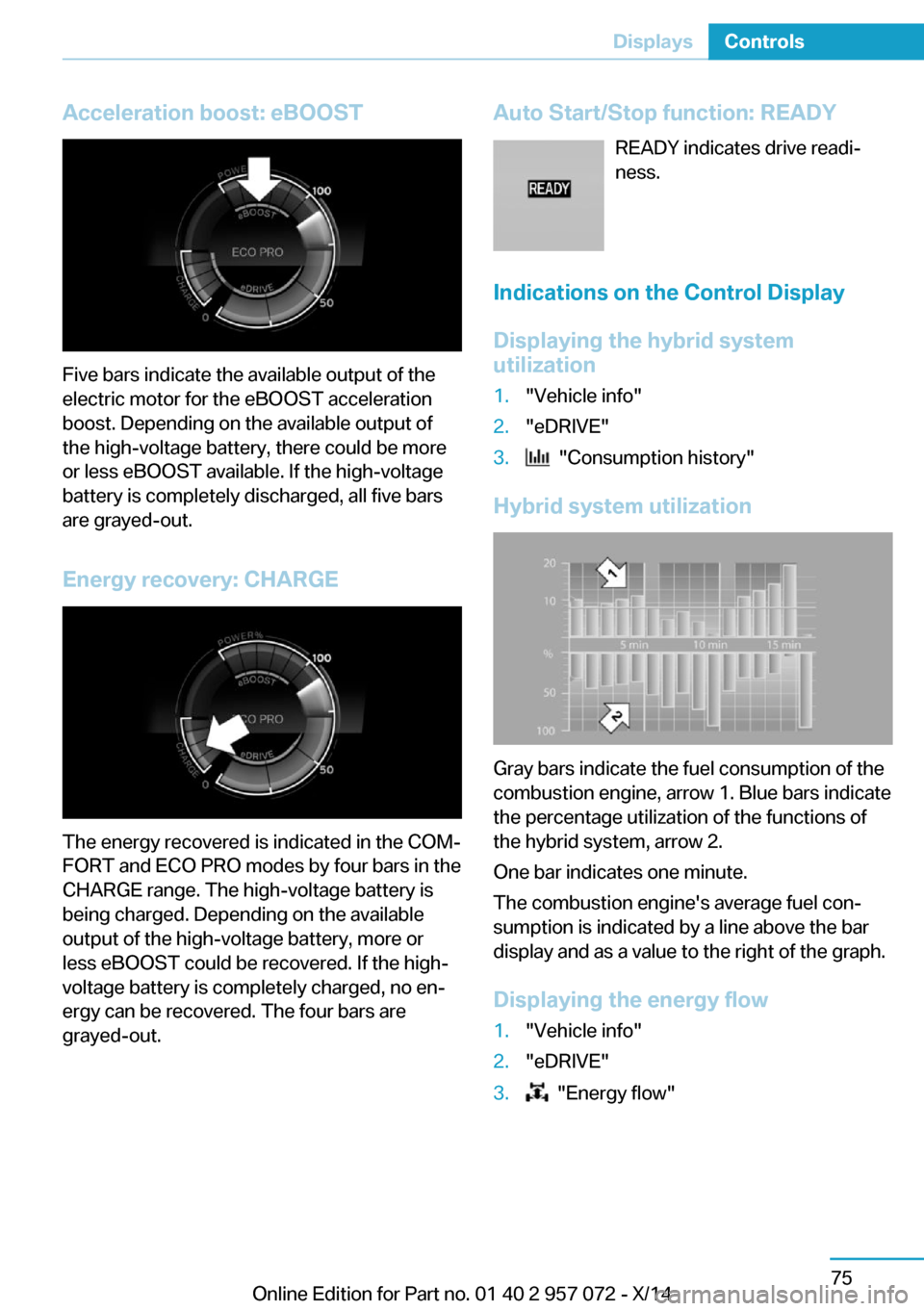
Acceleration boost: eBOOST
Five bars indicate the available output of the
electric motor for the eBOOST acceleration
boost. Depending on the available output of
the high-voltage battery, there could be more
or less eBOOST available. If the high-voltage
battery is completely discharged, all five bars
are grayed-out.
Energy recovery: CHARGE
The energy recovered is indicated in the COMā
FORT and ECO PRO modes by four bars in the
CHARGE range. The high-voltage battery is
being charged. Depending on the available
output of the high-voltage battery, more or
less eBOOST could be recovered. If the high-
voltage battery is completely charged, no enā
ergy can be recovered. The four bars are
grayed-out.
Auto Start/Stop function: READY
READY indicates drive readiā
ness.
Indications on the Control Display Displaying the hybrid system
utilization1."Vehicle info"2."eDRIVE"3. "Consumption history"
Hybrid system utilization
Gray bars indicate the fuel consumption of the
combustion engine, arrow 1. Blue bars indicate
the percentage utilization of the functions of
the hybrid system, arrow 2.
One bar indicates one minute.
The combustion engine's average fuel conā
sumption is indicated by a line above the bar
display and as a value to the right of the graph.
Displaying the energy flow
1."Vehicle info"2."eDRIVE"3. "Energy flow"Seite 75DisplaysControls75
Online Edition for Part no. 01 40 2 957 072 - X/14
Page 100 of 216
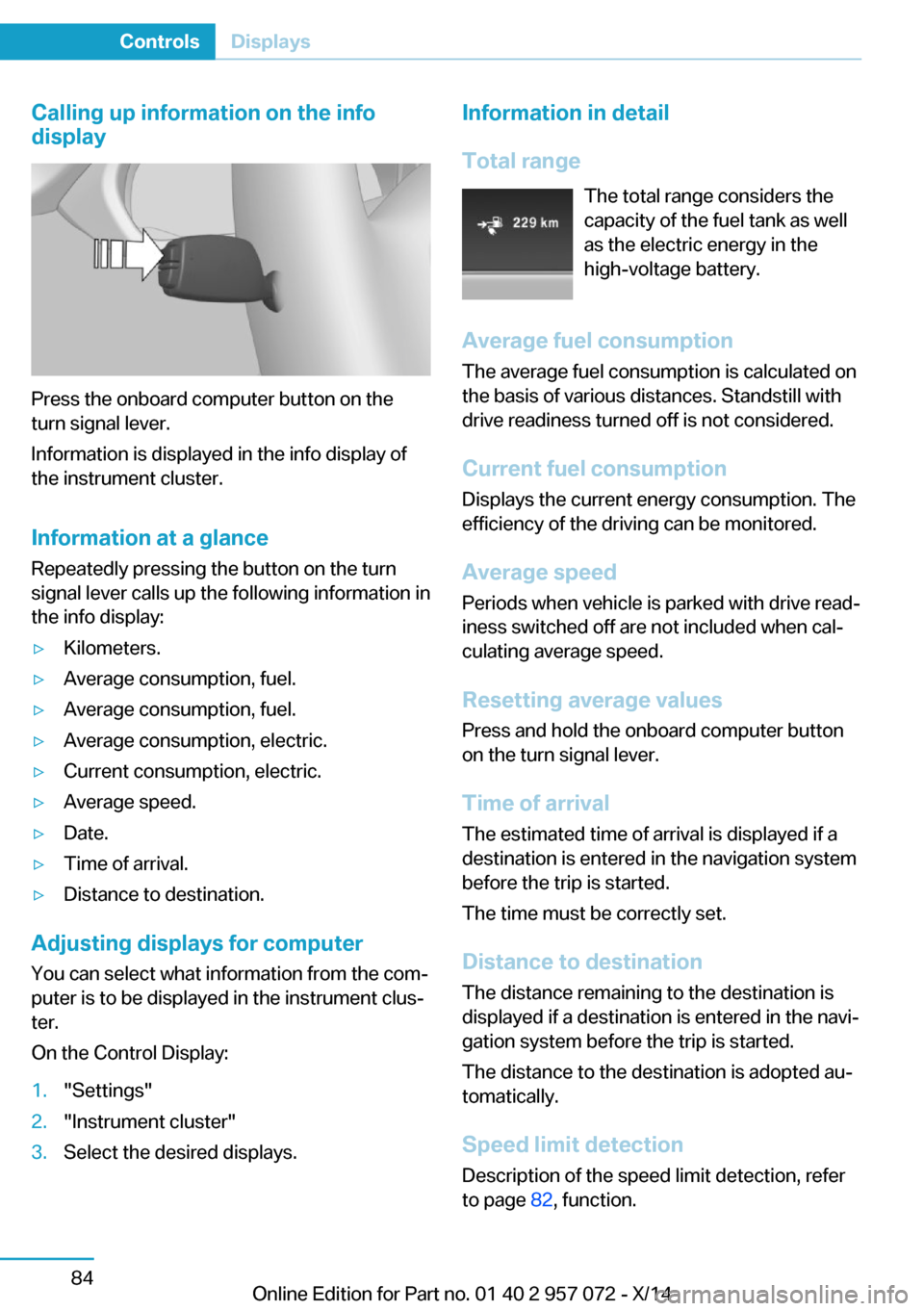
Calling up information on the info
display
Press the onboard computer button on the
turn signal lever.
Information is displayed in the info display of
the instrument cluster.
Information at a glance
Repeatedly pressing the button on the turn
signal lever calls up the following information in
the info display:
ā·Kilometers.ā·Average consumption, fuel.ā·Average consumption, fuel.ā·Average consumption, electric.ā·Current consumption, electric.ā·Average speed.ā·Date.ā·Time of arrival.ā·Distance to destination.
Adjusting displays for computer
You can select what information from the comā
puter is to be displayed in the instrument clusā
ter.
On the Control Display:
1."Settings"2."Instrument cluster"3.Select the desired displays.Information in detail
Total range The total range considers the
capacity of the fuel tank as well
as the electric energy in the
high-voltage battery.
Average fuel consumption
The average fuel consumption is calculated on
the basis of various distances. Standstill with
drive readiness turned off is not considered.
Current fuel consumption Displays the current energy consumption. The
efficiency of the driving can be monitored.
Average speed
Periods when vehicle is parked with drive readā
iness switched off are not included when calā
culating average speed.
Resetting average values Press and hold the onboard computer button
on the turn signal lever.
Time of arrival
The estimated time of arrival is displayed if a
destination is entered in the navigation system
before the trip is started.
The time must be correctly set.
Distance to destination
The distance remaining to the destination is
displayed if a destination is entered in the naviā
gation system before the trip is started.
The distance to the destination is adopted auā
tomatically.
Speed limit detection
Description of the speed limit detection, refer
to page 82, function.Seite 84ControlsDisplays84
Online Edition for Part no. 01 40 2 957 072 - X/14
Page 101 of 216
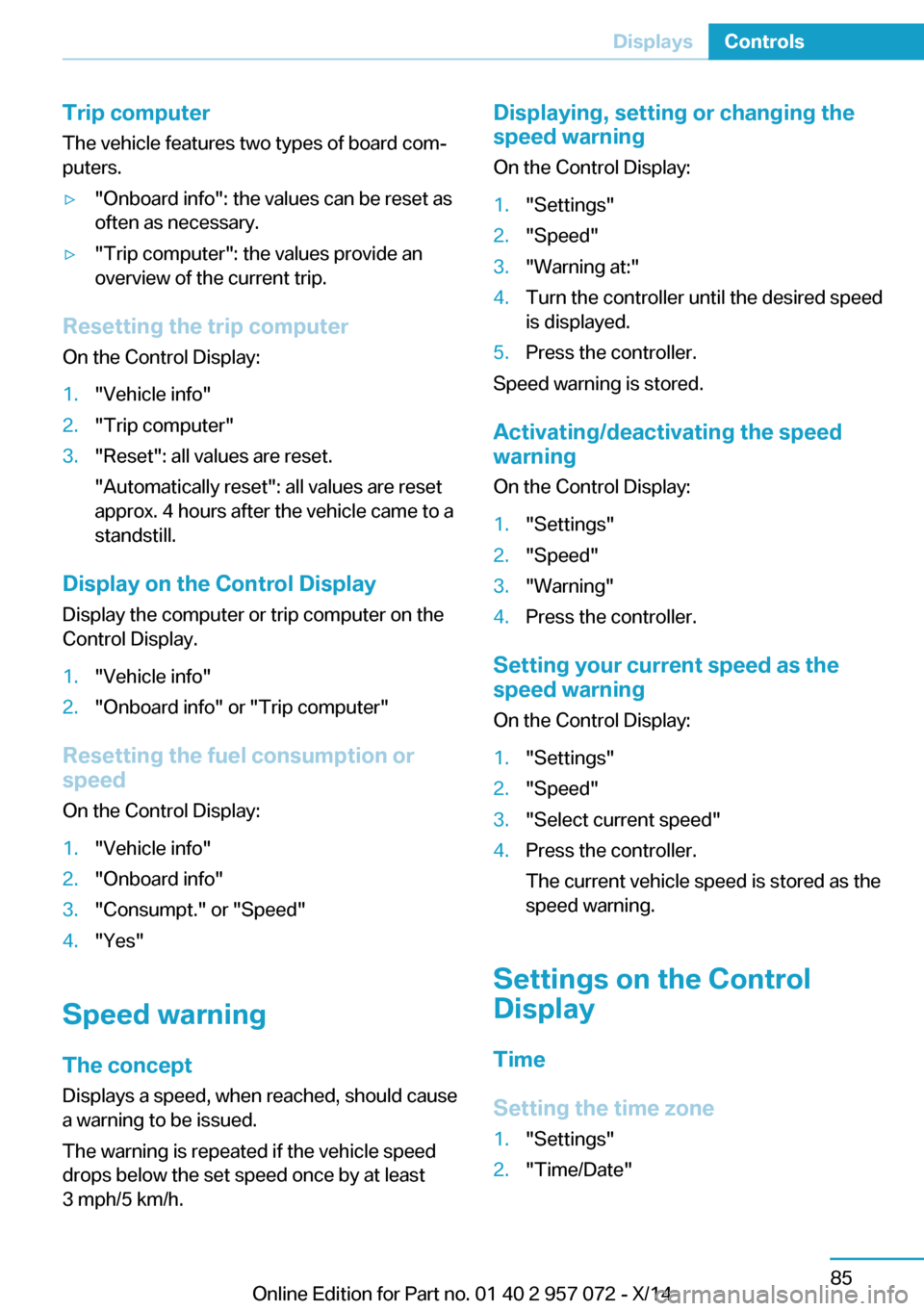
Trip computerThe vehicle features two types of board comā
puters.ā·"Onboard info": the values can be reset as
often as necessary.ā·"Trip computer": the values provide an
overview of the current trip.
Resetting the trip computer
On the Control Display:
1."Vehicle info"2."Trip computer"3."Reset": all values are reset.
"Automatically reset": all values are reset
approx. 4 hours after the vehicle came to a
standstill.
Display on the Control Display
Display the computer or trip computer on the
Control Display.
1."Vehicle info"2."Onboard info" or "Trip computer"
Resetting the fuel consumption or
speed
On the Control Display:
1."Vehicle info"2."Onboard info"3."Consumpt." or "Speed"4."Yes"
Speed warning
The concept Displays a speed, when reached, should cause
a warning to be issued.
The warning is repeated if the vehicle speed
drops below the set speed once by at least
3 mph/5 km/h.
Displaying, setting or changing the
speed warning
On the Control Display:1."Settings"2."Speed"3."Warning at:"4.Turn the controller until the desired speed
is displayed.5.Press the controller.
Speed warning is stored.
Activating/deactivating the speed
warning
On the Control Display:
1."Settings"2."Speed"3."Warning"4.Press the controller.
Setting your current speed as the
speed warning
On the Control Display:
1."Settings"2."Speed"3."Select current speed"4.Press the controller.
The current vehicle speed is stored as the
speed warning.
Settings on the Control
Display
Time
Setting the time zone
1."Settings"2."Time/Date"Seite 85DisplaysControls85
Online Edition for Part no. 01 40 2 957 072 - X/14
Page 102 of 216
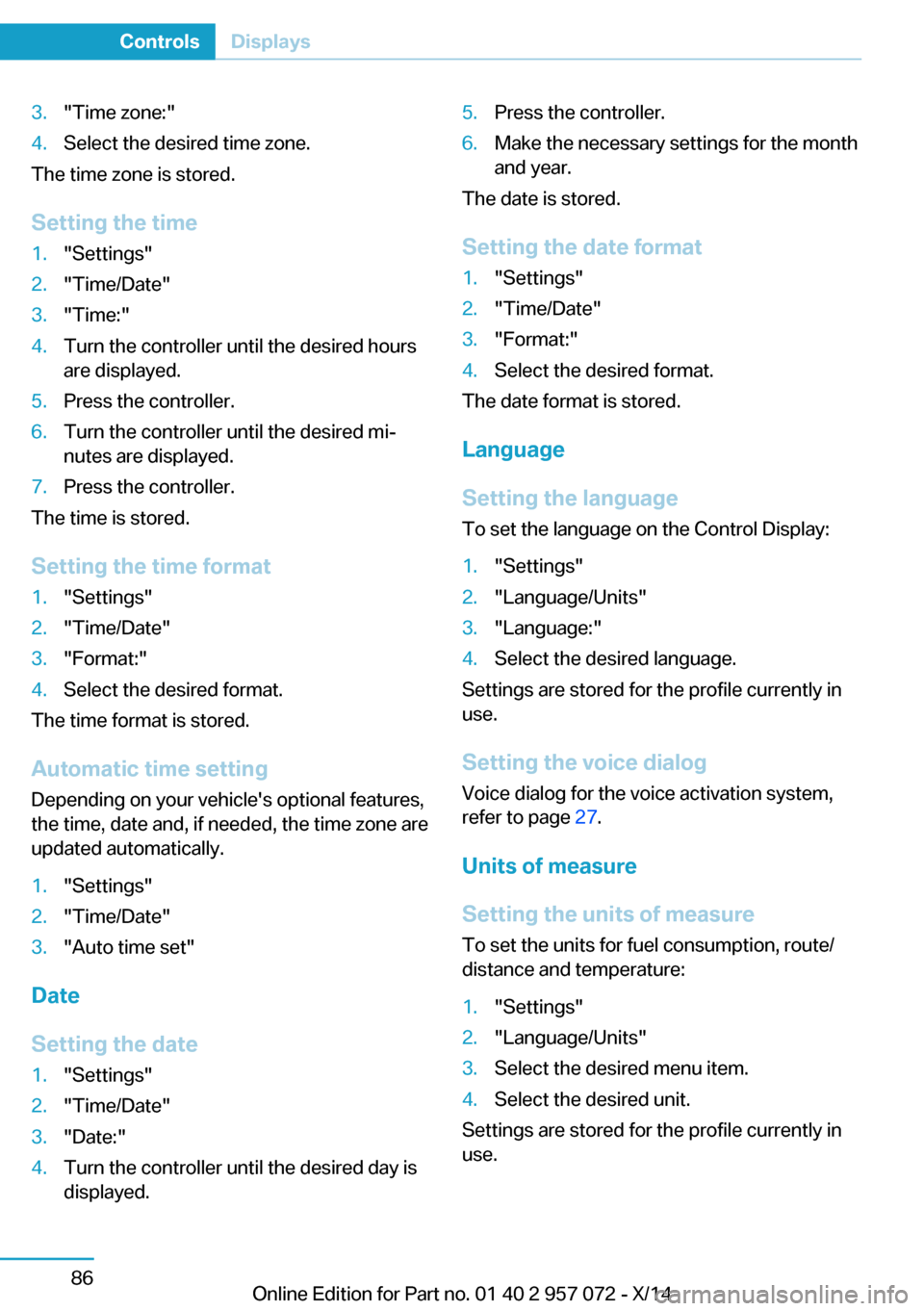
3."Time zone:"4.Select the desired time zone.
The time zone is stored.
Setting the time
1."Settings"2."Time/Date"3."Time:"4.Turn the controller until the desired hours
are displayed.5.Press the controller.6.Turn the controller until the desired miā
nutes are displayed.7.Press the controller.
The time is stored.
Setting the time format
1."Settings"2."Time/Date"3."Format:"4.Select the desired format.
The time format is stored.
Automatic time setting Depending on your vehicle's optional features,
the time, date and, if needed, the time zone are
updated automatically.
1."Settings"2."Time/Date"3."Auto time set"
Date
Setting the date
1."Settings"2."Time/Date"3."Date:"4.Turn the controller until the desired day is
displayed.5.Press the controller.6.Make the necessary settings for the month
and year.
The date is stored.
Setting the date format
1."Settings"2."Time/Date"3."Format:"4.Select the desired format.
The date format is stored.
Language
Setting the language
To set the language on the Control Display:
1."Settings"2."Language/Units"3."Language:"4.Select the desired language.
Settings are stored for the profile currently in
use.
Setting the voice dialog
Voice dialog for the voice activation system,
refer to page 27.
Units of measure
Setting the units of measure
To set the units for fuel consumption, route/
distance and temperature:
1."Settings"2."Language/Units"3.Select the desired menu item.4.Select the desired unit.
Settings are stored for the profile currently in
use.
Seite 86ControlsDisplays86
Online Edition for Part no. 01 40 2 957 072 - X/14
Page 151 of 216
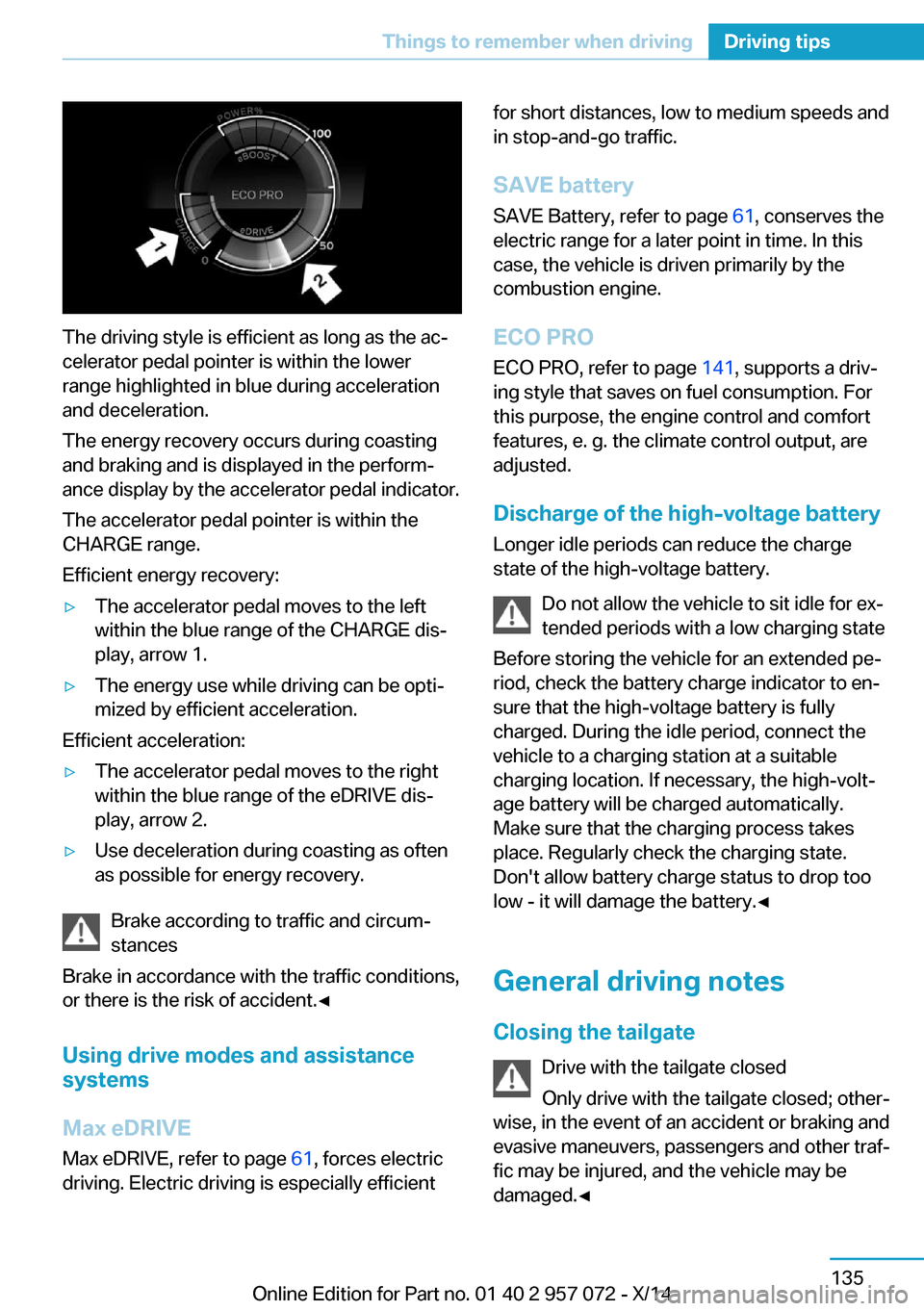
The driving style is efficient as long as the acā
celerator pedal pointer is within the lower
range highlighted in blue during acceleration
and deceleration.
The energy recovery occurs during coasting
and braking and is displayed in the performā
ance display by the accelerator pedal indicator.
The accelerator pedal pointer is within the
CHARGE range.
Efficient energy recovery:
ā·The accelerator pedal moves to the left
within the blue range of the CHARGE disā
play, arrow 1.ā·The energy use while driving can be optiā
mized by efficient acceleration.
Efficient acceleration:
ā·The accelerator pedal moves to the right
within the blue range of the eDRIVE disā
play, arrow 2.ā·Use deceleration during coasting as often
as possible for energy recovery.
Brake according to traffic and circumā
stances
Brake in accordance with the traffic conditions,
or there is the risk of accident.ā
Using drive modes and assistance
systems
Max eDRIVE
Max eDRIVE, refer to page 61, forces electric
driving. Electric driving is especially efficient
for short distances, low to medium speeds and
in stop-and-go traffic.
SAVE battery
SAVE Battery, refer to page 61, conserves the
electric range for a later point in time. In this
case, the vehicle is driven primarily by the
combustion engine.
ECO PRO ECO PRO, refer to page 141, supports a drivā
ing style that saves on fuel consumption. For
this purpose, the engine control and comfort
features, e. g. the climate control output, are
adjusted.
Discharge of the high-voltage battery Longer idle periods can reduce the charge
state of the high-voltage battery.
Do not allow the vehicle to sit idle for exā
tended periods with a low charging state
Before storing the vehicle for an extended peā
riod, check the battery charge indicator to enā
sure that the high-voltage battery is fully
charged. During the idle period, connect the
vehicle to a charging station at a suitable
charging location. If necessary, the high-voltā
age battery will be charged automatically.
Make sure that the charging process takes
place. Regularly check the charging state.
Don't allow battery charge status to drop too
low - it will damage the battery.ā
General driving notes
Closing the tailgate Drive with the tailgate closed
Only drive with the tailgate closed; otherā
wise, in the event of an accident or braking and
evasive maneuvers, passengers and other trafā
fic may be injured, and the vehicle may be
damaged.āSeite 135Things to remember when drivingDriving tips135
Online Edition for Part no. 01 40 2 957 072 - X/14
Page 156 of 216
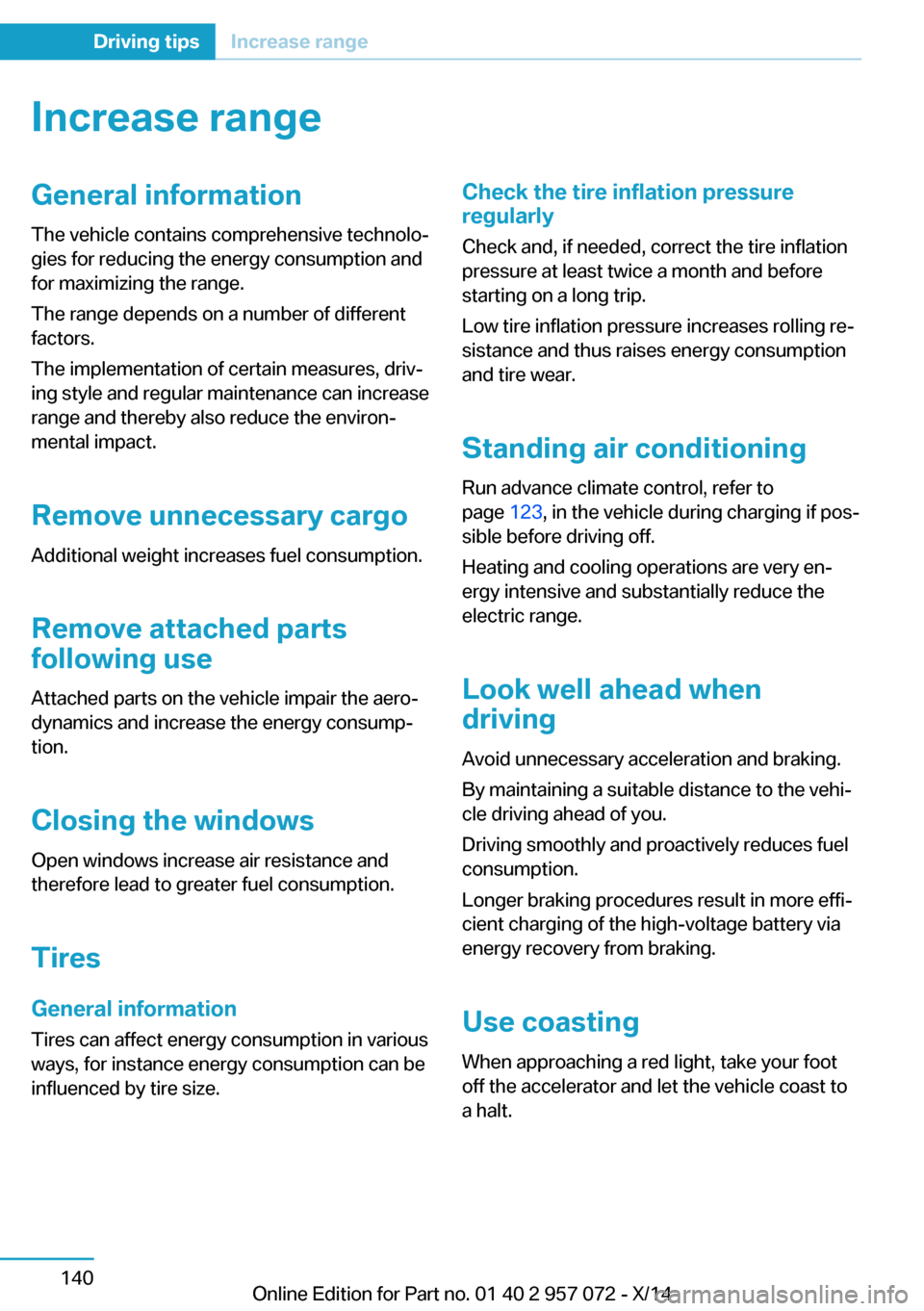
Increase rangeGeneral informationThe vehicle contains comprehensive technoloā
gies for reducing the energy consumption and
for maximizing the range.
The range depends on a number of different
factors.
The implementation of certain measures, drivā
ing style and regular maintenance can increase
range and thereby also reduce the environā
mental impact.
Remove unnecessary cargo
Additional weight increases fuel consumption.
Remove attached parts
following use
Attached parts on the vehicle impair the aeroā
dynamics and increase the energy consumpā
tion.
Closing the windows
Open windows increase air resistance and
therefore lead to greater fuel consumption.
Tires General information Tires can affect energy consumption in various
ways, for instance energy consumption can be
influenced by tire size.Check the tire inflation pressure
regularly
Check and, if needed, correct the tire inflationpressure at least twice a month and before
starting on a long trip.
Low tire inflation pressure increases rolling reā
sistance and thus raises energy consumption
and tire wear.
Standing air conditioning Run advance climate control, refer to
page 123, in the vehicle during charging if posā
sible before driving off.
Heating and cooling operations are very enā
ergy intensive and substantially reduce the
electric range.
Look well ahead when
driving
Avoid unnecessary acceleration and braking.
By maintaining a suitable distance to the vehiā
cle driving ahead of you.
Driving smoothly and proactively reduces fuel
consumption.
Longer braking procedures result in more effiā
cient charging of the high-voltage battery via
energy recovery from braking.
Use coasting
When approaching a red light, take your foot
off the accelerator and let the vehicle coast to
a halt.Seite 140Driving tipsIncrease range140
Online Edition for Part no. 01 40 2 957 072 - X/14